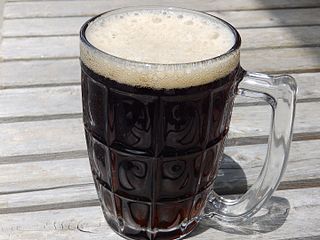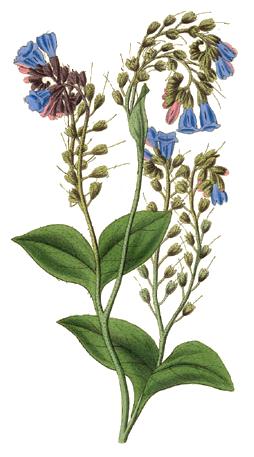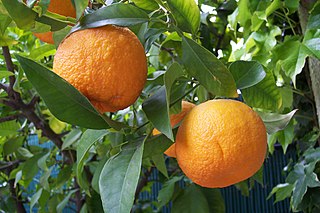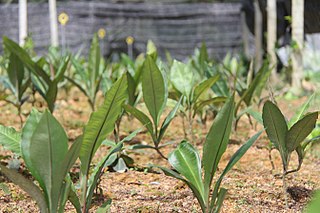
Stevia is a natural sweetener and sugar substitute derived from the leaves of the plant species Stevia rebaudiana, native to Paraguay and Brazil.

Root beer is a sweet North American soft drink traditionally made using the root bark of the sassafras tree Sassafras albidum or the vine of Smilax ornata as the primary flavor. Root beer is typically, but not exclusively, non-alcoholic, caffeine-free, sweet, and carbonated. Like cola, it usually has a thick and foamy head. A well-known use is to add vanilla ice cream to make a root beer float.

Symphytum is a genus of flowering plants in the borage family, Boraginaceae, known by the common name comfrey. There are 59 recognized species. Some species and hybrids, particularly S. officinale, Symphytum grandiflorum, and S. × uplandicum, are used in gardening and herbal medicine. They are not to be confused with Andersonglossum virginianum, known as wild comfrey, another member of the borage family.

A dietary supplement is a manufactured product intended to supplement one's diet by taking a pill, capsule, tablet, powder, or liquid. A supplement can provide nutrients either extracted from food sources or that are synthetic in order to increase the quantity of their consumption. The class of nutrient compounds includes vitamins, minerals, fiber, fatty acids, and amino acids. Dietary supplements can also contain substances that have not been confirmed as being essential to life, but are marketed as having a beneficial biological effect, such as plant pigments or polyphenols. Animals can also be a source of supplement ingredients, such as collagen from chickens or fish for example. These are also sold individually and in combination, and may be combined with nutrient ingredients. The European Commission has also established harmonized rules to help insure that food supplements are safe and appropriately labeled.

Curcumin is a bright yellow chemical produced by plants of the Curcuma longa species. It is the principal curcuminoid of turmeric, a member of the ginger family, Zingiberaceae. It is sold as a herbal supplement, cosmetics ingredient, food flavoring, and food coloring.

Actaea racemosa, the black cohosh, black bugbane, black snakeroot, rattle-top, or fairy candle, is a species of flowering plant of the family Ranunculaceae. It is native to eastern North America from the extreme south of Ontario to central Georgia, and west to Missouri and Arkansas. It grows in a variety of woodland habitats, and is often found in small woodland openings. The roots and rhizomes were used in traditional medicine by Native Americans. Its extracts are manufactured as herbal medicines or dietary supplements. Most dietary supplements containing black cohosh are not well-studied or recommended for safe and effective use in treating menopause symptoms or any disease. In contrast, some herbal medicinal products containing black cohosh extract hold a marketing authorization in several states of the European Union and are well-studied and recommended for safe and effective use for the relief of menopausal symptoms such as hot flushes and profuse sweating attacks. Such differentiation between the product types seems to be important.

Bitter orange, sour orange, Seville orange, bigarade orange, or marmalade orange is the citrus tree Citrus × aurantium and its fruit. It is native to Southeast Asia and has been spread by humans to many parts of the world. It is probably a cross between the pomelo, Citrus maxima, and the mandarin orange, Citrus reticulata.

Chinese herbology is the theory of traditional Chinese herbal therapy, which accounts for the majority of treatments in traditional Chinese medicine (TCM). A Nature editorial described TCM as "fraught with pseudoscience", and said that the most obvious reason why it has not delivered many cures is that the majority of its treatments have no logical mechanism of action.

Herbal medicine is the study of pharmacognosy and the use of medicinal plants, which are a basis of traditional medicine. With worldwide research into pharmacology, some herbal medicines have been translated into modern remedies, such as the anti-malarial group of drugs called artemisinin isolated from Artemisia annua, a herb that was known in Chinese medicine to treat fever. There is limited scientific evidence for the safety and efficacy of many plants used in 21st century herbalism, which generally does not provide standards for purity or dosage. The scope of herbal medicine sometimes include fungal and bee products, as well as minerals, shells and certain animal parts.

Ginseng is the root of plants in the genus Panax, such as Korean ginseng, South China ginseng, and American ginseng, typically characterized by the presence of ginsenosides and gintonin. Ginseng is most commonly used in the cuisines and medicines of China and Korea.

Mitragyna speciosa is a tropical evergreen tree in the coffee family native to Southeast Asia. It is indigenous to Thailand, Indonesia, Malaysia, Myanmar, and Papua New Guinea, where it has been used in herbal medicine since at least the 19th century. It has also historically been used for chewing, smoking, and tea. Kratom has opioid properties and some stimulant-like effects.

Cannabidiol (CBD) is a phytocannabinoid discovered in 1940. It is one of 113 identified cannabinoids in cannabis plants, along with tetrahydrocannabinol (THC), and accounts for up to 40% of the plant's extract. As of 2019, clinical research on CBD included studies related to anxiety, cognition, movement disorders, and pain, but there is insufficient high-quality evidence that cannabidiol is effective for these conditions. Nevertheless, CBD is a herbal dietary supplement promoted with unproven claims of particular therapeutic effects. The global market size for CBD was predicted to exceed US$47 billion by 2028.
Natural skin care uses topical creams and lotions made of ingredients available in nature. Much of the recent literature reviews plant-derived ingredients, which may include herbs, roots, flowers and essential oils, but natural substances in skin care products include animal-derived products such as beeswax, and minerals. These substances may be combined with various carrier agents, preservatives, surfactants, humectants and emulsifiers.
Hydroxycut is a brand of dietary supplements that is marketed as a weight loss aid. Hydroxycut was originally developed and manufactured by MuscleTech Research and Development; MuscleTech was sold to Iovate Health Sciences in 2003–2004 and declared bankruptcy in 2005; Iovate continues to use MuscleTech as a brand to market Hydroxycut.

Labisia pumila is a flowering plant in the family Primulaceae native to Malaysia. It is a small, woody and leafy plant with leaves of 20 cm (7.9 in) in length, and grows widely in the shade of the tropical forest floor. The plant is popular in the traditional medicine of the Malaysian and Indonesian community, in which it is believed to be the female version of the equally well-known tongkat Ali, i.e. Ali's walking stick.
Protandim is a herbal dietary supplement marketed with unsupported claims that it can treat a number of medical conditions. The product is a patented mix of five herbal ingredients and sold by LifeVantage Corporation, a Utah-based multi-level marketing company. The manufacturers of Protandim claim it can prevent or cure a wide variety of medical conditions. In 2017, LifeVantage was issued a warning letter by the U.S. Food and Drug Administration (FDA) regarding illegal advertising claims on the company's websites suggesting that Protandim can help to cure various ailments, including cancer and diabetes.
Ramuan is an Indonesian-Malay term referring to a blend of ingredients selected to provide health benefits in the preparation of food or the creation of herbal medicines.

Sulfoaildenafil (thioaildenafil) is a synthetic drug that is a structural analog of sildenafil (Viagra). It was first reported in 2005, and it is not approved by any health regulation agency. Like sildenafil, sulfoaildenafil is a phosphodiesterase type 5 inhibitor.

A botanical drug is defined in the United States Federal Food, Drug, and Cosmetic Act as a botanical product that is marketed as diagnosing, mitigating, treating, or curing a disease; a botanical product in turn, is a finished, labeled product that contains ingredients from plants. Chemicals that are purified from plants, like paclitaxel, and highly purified products of industrial fermentation, like biopharmaceuticals, are not considered to be botanical products.

Eurycomanone is a chemical compound that has been isolated from Eurycoma longifolia, also known as the longjack plant or tongkat ali.
















